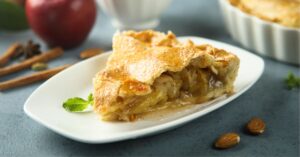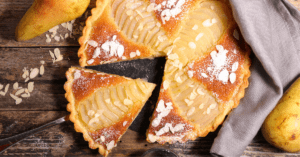Pie vs. tart: what exactly is the difference?
They both have a tender crust and a tasty filling. But they are as different as night and day!

For example, there are differences in the crust, pan shape, fillings, and culinary traditions.
And while pies are all about that filling, tarts have a more delicate crust-to-filling ratio.
But one thing these two culinary classics have in common? They are comfort food at its finest. Oh, and they are absolutely delicious!
So let’s dive into the subtle differences between pies and tarts!

Are Pies and Tarts the Same?
Pies and tarts are very similar, but they are not the same.
Pies are bigger with much more filling.
Some have a single layer of pastry in the crust. Others have a second layer of pastry covering the top.
Either way, the thick filling stands out from the lighter filling in tarts.
Want to learn more? Let’s look a little deeper into what pies and tarts are. That way, we can better understand how they are different.
What Is a Pie?
A traditional pie features a sweet or savory filling encased in pastry.
They often call for a flaky, buttery crust that’s hearty enough to carry dense fillings. Think apple pie.
Pies come in all types. You can try custard pies, summer fruit pies, or savory pies. There are pies with candy, cookies, nuts, and chocolate!
The most important part is to make sure the crust bakes perfectly. Nobody wants the dreaded soggy bottom.
We all know how Paul Hollywood feels about a soggy bottom, right?
What Is a Tart?
Tarts often feature sweet fillings in an open pastry case.
They are an elegant staple popular in French cuisine. And they often include a shortbread-like crust with all kinds of fillings.
Unlike pies, which have thick layers of filling, tarts have a 1:1 filling-to-crust ratio. This creates the perfect texture.
And the texture is the key to tarts.
Common tart fillings include silky smooth fruit compote, chocolate ganache, or lemon curd. Baked fruits like apples or pears are popular, too.
And some have frangipane, marzipan, or other pastry creams.
That said, tarts can also be savory. For example, quiche is a super popular type of tart.
Unlike pies, you remove tarts from their baking tin. Then, place them on a decorative plate. It is a show-stopping presentation!

Pie vs. Tart (What’s the Difference?)
Both can be sweet or savory. And both are delicious. But there are five key differences between a pie and a tart.
Crust
Pies and tarts almost always use some variety of pastry. That includes puff pastry, shortcrust pastry, flaky pastry, and more.
Of course, there are also cookie or cracker crumb cases, but that’s for another post!
The crust I am talking about contains flour, butter, water, and salt.
But how are they so different?
- Pie crusts incorporate flour, fat, cold water, and salt. They are flakey yet hearty enough for dense fillings when baked.
- Tart shells call for flour, butter, water, and sometimes sugar. The pastry is usually more crumbly texture, like a shortbread cookie.
Pie crusts are hearty, while tart shells are incredibly delicate.
Pan Shape
Pie pans are round, but tart pans can be round, oval, or square!
The overall shape of the pan plays a big part in how the fillings distribute. Plus, it adds to the overall presentation.
- Pie pans have more depth for juicy fillings. They are usually 2 inches deep, and the standard size is 9 inches around.
- Tart pans are shallow and never exceed 1.5 inches deep. They measure anywhere between 4 and 12 inches around.
The shape of the pan doesn’t affect the taste but adds to the overall presentation. Is there anything prettier than a perfectly square tart?
Fillings
Another significant difference between these two pastries lies in the filling.
Pie fillings take center stage. But tart fillings help accent the crumbly crust.
- Tasty pie fillings are the main event, while the crust plays second fiddle. Fantastic pie fillings include baked apples, pumpkin, chocolate, peanut butter, or savory meats.
- Tart fillings are equally as important as the crust. The filling of a tart is (often) unbaked. They include silky smooth fruit compotes, custard, pastry cream, or chocolate ganache.
- These fillings accent the crust in a 1:1 ratio.
It is important to note that pie and tart fillings are not always sweet! Their delicate pastry crusts are also great hosts for savory meats and cheeses.
How They’re Served
Presentation plays a big part in the difference between pies and tarts.
Pies get a little bit of a pass in the presentation department. But tarts require a little more finesse.
- You always serve pies in their original baking dish. As it is such a hearty dessert, removing the pie from the pan is challenging.
- So, decorative glass pie pans are a great way to jazz up their presentation!
- Remove tarts from their baking pan and placed on a decorative plate. Unlike pie pans, many tart pans have removable sides to make this process easier.
- Presentation of the tart is a big part of its culinary tradition.
Culinary Traditions
Pies and tarts play a significant role in culinary traditions across the globe.
Think, as American as apple pie! (Although, it actually originates in England with influences from the French and Dutch.)
And tarts come from France, originally.
- Pies are classic comfort food in countries like the US, Canada, Australia, and the UK. Fruit pies, custard pies, and savory pies (like steak pies) are hallmarks of these regions.
- The tart is the ultimate dessert in France, Italy, and Portugal. Tarts are cultural touchstones in these European countries, known for their refined elegance and presentation.
But like all great foods, both dishes are sought-after in bakeries everywhere!

Pastry Recipe for Pies and Tarts (Pâte Brisée)
As mentioned, pies and tarts use different pastry.
Pie dough is quite flaky. And many times, you must support the bottom slice so it doesn’t break.
However, tart dough is buttery and short- meaning it’s crumbly yet firm. Sweet shortcrust has a texture like cookie dough.
That said, Pâte Brisée is an excellent pastry for both pies and tarts. It is buttery, light, sweet, and relatively easy to make.
Here is what you need to make Pâte Brisée:
- All-Purpose Flour
- Salt
- Sugar
- Butter
- Ice Water
As you can see, it is like many pastry recipes. And the method is comparable, too.
Here are the basic steps:
- Mix the flour with the salt and sugar.
- Cut the butter into the flour until it is crumbly.
- Slowly add the ice water and gently work it into a shaggy dough.
- Knead the pastry a few times, then wrap and chill for 1 hour before use.
It is important not to overwork the dough.
So, stop mixing in the bowl when it’s still shaggy (not smooth). Then, press and knead the dough on the counter until it (just) comes together.
After it chills, you can make all kinds of tasty pies and tarts. In fact, it’s my go-to pastry when making holiday desserts.
With that in mind, here are a few ideas for how to use Pâte Brisée:












Hi Kim, do you have recipes for quiche that I could try. I love making quiche for friend and family. I just need to try something new.
Here you go, Kate! Try these 25 easy quiche recipes! Here are a few more vegetarian quiche recipes.
Hi, I love your recipes 💗 My grandkids love it also when I bake with your recipes. THANKX 4 SHARING 😘♥️
Hi Zoraida, I’m so happy to hear you and your grandkids like them!